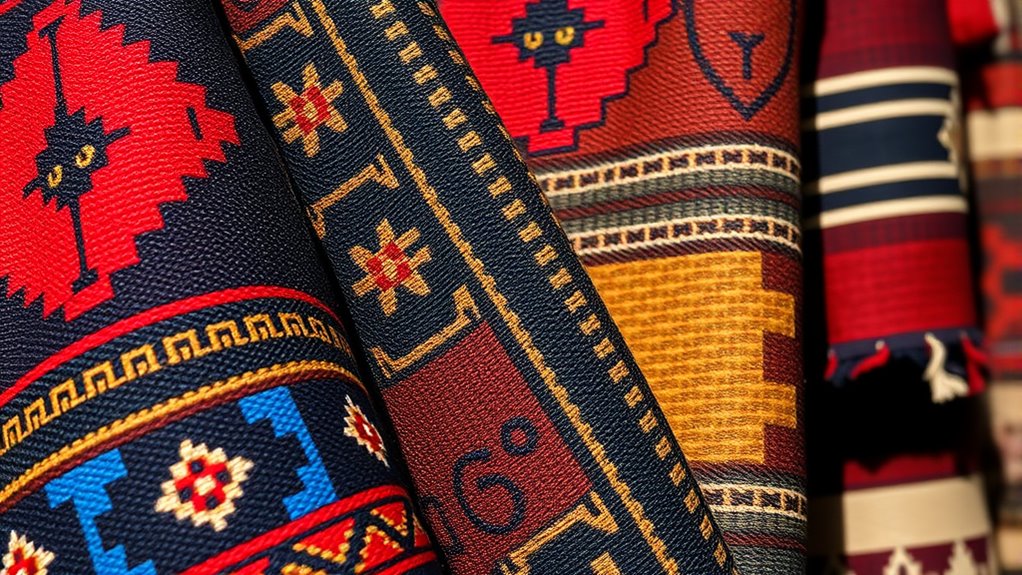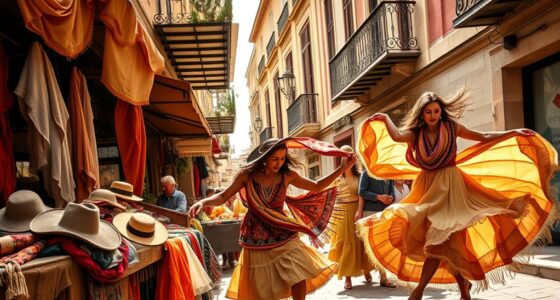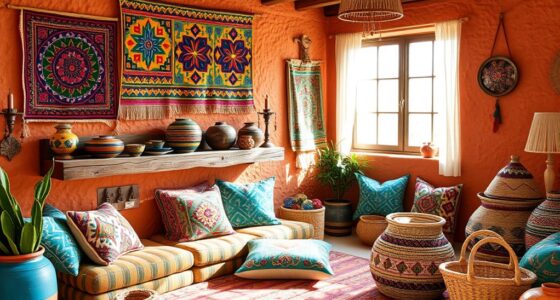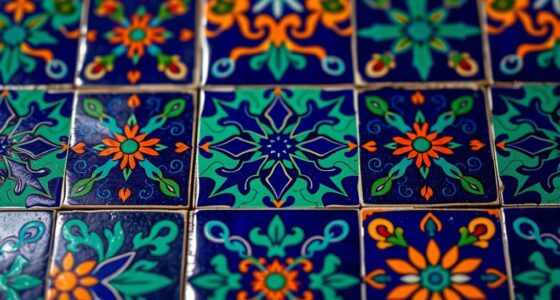Traditional African textiles are rich with meaning and cultural significance. You’ll find that Kente Cloth in Ghana tells stories through vibrant colors and patterns reflecting history and social status. Mudcloth in West Africa uses natural dyes and symbols to convey stories and resilience, while Shweshwe patterns and colors reflect identity and community values. Beaded textiles and Adire fabrics also communicate social roles, spiritual beliefs, and heritage. If you continue exploring, you’ll uncover the fascinating stories woven into each of these timeless textiles.
Key Takeaways
- Traditional African textiles like Kente, Mudcloth, and Kuba embody cultural stories, social status, and spiritual beliefs through patterns, colors, and symbols.
- Specific motifs and colors in textiles convey messages about identity, community ties, and rites of passage.
- Techniques such as resist dyeing, weaving, and beading preserve cultural heritage and symbolize historical values.
- Textiles are used in ceremonies and rituals to honor ancestors, mark important events, and express spiritual beliefs.
- The craftsmanship and symbolism in African textiles serve as a visual language connecting individuals to their cultural identity.
The Significance of Kente Cloth in Ghanaian Culture
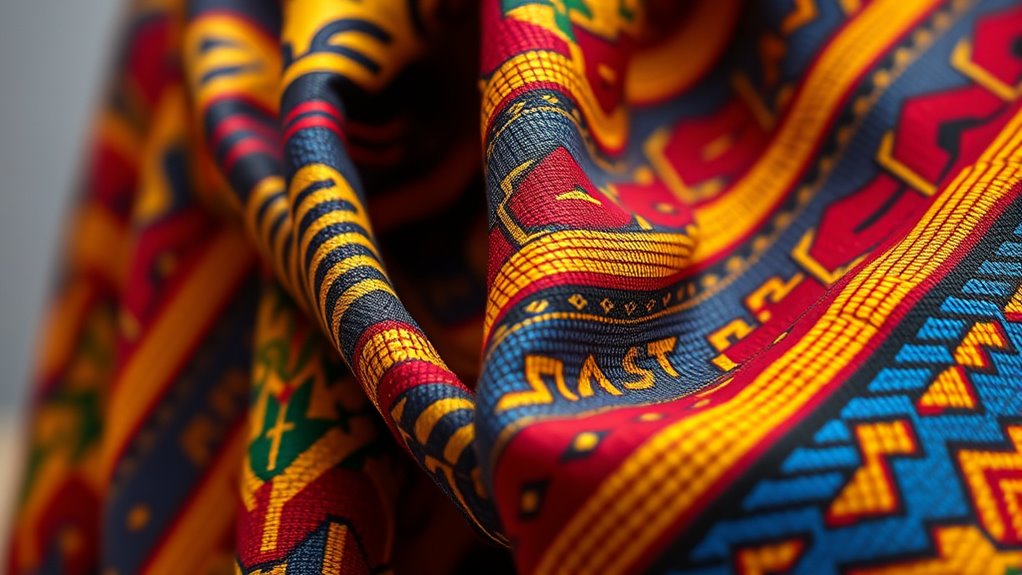
Have you ever wondered why Kente cloth holds such a special place in Ghanaian culture? The intricate weaving techniques used to create Kente are a essential part of its significance. Skilled artisans carefully weave vibrant strips of fabric, often by hand, using traditional methods passed down through generations. This craftsmanship not only produces stunning patterns but also helps with textile preservation, ensuring these cultural symbols endure over time. Kente’s bright colors and complex designs communicate stories, social status, and cultural values, making it more than just cloth. Wearing Kente connects you to Ghana’s history and identity, highlighting the importance of preserving these traditional weaving techniques for future generations. It’s a living expression of Ghanaian pride and heritage. Additionally, the textile preservation process is vital for maintaining the authenticity and cultural integrity of Kente weaving techniques.
The History and Meaning of Mudcloth in West Africa

Did you know that mudcloth, also known as bogolanfini, has been an essential part of West African culture for centuries? This textile’s history begins with traditional dyeing techniques where artisans use fermented mud to create distinctive patterns. Each motif tells a story or signifies social status, making mudcloth more than just fabric—it’s a form of communication. The process involves textile preservation methods passed down through generations, ensuring cultural identity remains intact. Mudcloth’s unique appearance results from careful application of mud and natural dyes, making each piece one-of-a-kind. Additionally, the dyeing techniques used in creating mudcloth are considered a form of artistic expression that embodies cultural values and storytelling. Over time, mudcloth has become a symbol of cultural pride and resilience, connecting communities to their history. Its enduring significance highlights the importance of preserving traditional dyeing techniques in West African textile heritage.
Symbolism Behind the Patterns of Shweshwe Fabric

You can see that the patterns on Shweshwe fabric carry deep cultural meanings and reflect regional identities. These motifs often symbolize social status, community ties, or spiritual beliefs. By exploring the variations in patterns across regions, you’ll better understand the rich symbolism woven into this iconic textile. Additionally, the use of natural materials in traditional dyeing methods further enhances the cultural significance of the fabric.
Cultural Significance of Motifs
The motifs on Shweshwe fabric are more than decorative; they carry deep cultural meanings that reflect identity, history, and social values. These symbolic motifs serve as a form of textile storytelling, conveying messages without words. Here’s what they represent:
- Status and Wealth — intricate patterns indicate social standing.
- Marital Status — specific motifs symbolize whether a woman is single or married.
- Cultural Heritage — traditional symbols honor ancestral roots.
- Moral Values — designs often reflect community virtues and ethics.
Regional Pattern Variations
Regional pattern variations in Shweshwe fabric reveal a rich tapestry of meanings rooted in local histories and cultural identities. Each pattern carries specific symbolism, often reflecting social status, community affiliation, or historical events. You’ll notice distinct regional pattern variations that help identify where the fabric originates, with designs unique to particular areas. These variations are achieved through traditional textile dye techniques, such as resist dyeing and indigo application. The choice of motifs and color combinations often convey messages or tell stories important to the community. By examining these patterns, you gain insight into the cultural nuances and history embedded within the fabric. Understanding the regional pattern variations of Shweshwe allows you to appreciate its cultural significance and the craftsmanship behind its creation. Textile dye techniques play a crucial role in preserving these regional differences and ensuring the longevity of traditional practices.
The Cultural Messages Conveyed by Beaded Textiles

Have you ever wondered what stories or messages beaded textiles carry beyond their vibrant colors and patterns? Beaded jewelry and textile dyeing techniques reveal much about cultural values. Here’s what they communicate:
- Social status: Elaborate beaded jewelry signifies wealth or high rank within the community.
- Identity: Specific patterns and bead colors identify tribal affiliations or familial ties.
- Rites of passage: Beaded textiles mark milestones like weddings, coming-of-age, or leadership transitions.
- Spiritual beliefs: Certain colors and designs symbolize spiritual protection or ancestral connections. Additionally, cultural expressions through textiles often serve as a form of storytelling that preserves history and tradition.
The Role of Adire in Yoruba Rituals and Celebrations
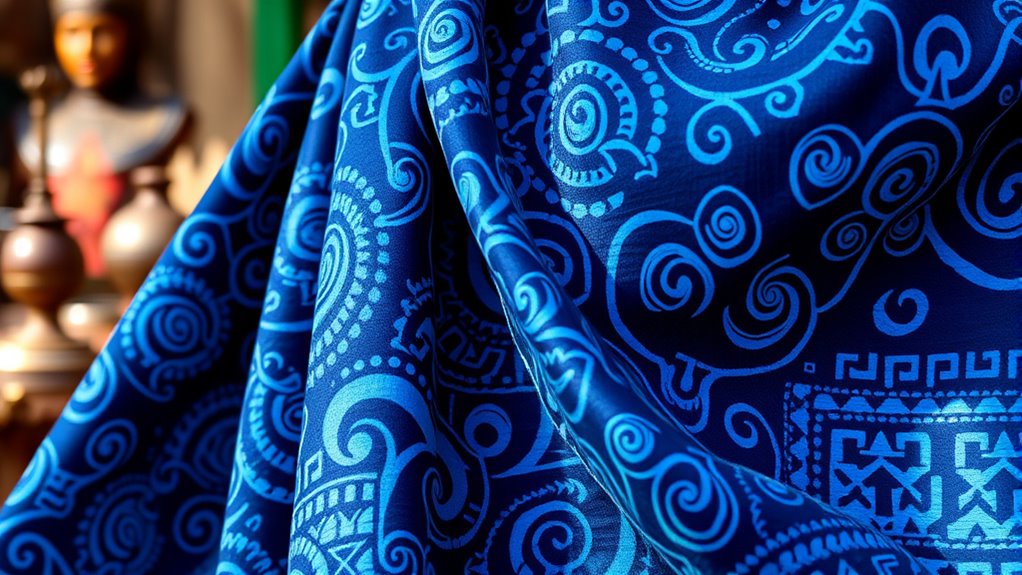
Adire fabrics hold deep significance in Yoruba culture, serving as symbols during important rituals and celebrations. The patterns woven into Adire often carry specific meanings, representing spiritual beliefs or social status. You’ll see these textiles used in ceremonies to honor ancestors, mark rites of passage, or celebrate community events. Additionally, the symbolism of patterns in Adire reflects a rich tradition of storytelling and cultural identity within Yoruba society.
Significance in Yoruba Culture
In Yoruba culture, textiles hold deep symbolic meaning, especially during important rituals and celebrations. Adire, a traditional Yoruba textile, is central to this significance. It’s used in various ways:
- To adorn Yoruba clothing, marking social status or spiritual roles.
- During ceremonies, where specific patterns symbolize different deities or ancestors.
- In Yoruba weaving, the process reflects cultural stories and beliefs, adding spiritual value.
- As gifts, representing respect and connection within communities.
- The intricate textile patterns often convey specific messages and histories, reinforcing cultural identity and continuity.
You recognize that these textiles aren’t just decorative but serve as powerful symbols of identity and tradition. Adire’s vibrant patterns and colors communicate messages across generations, making it an essential part of Yoruba ritual life and cultural expression.
Symbolism of Patterns
Did you know that the intricate patterns woven into Yoruba Adire carry powerful symbolic messages? These patterns and meanings go beyond decoration; they embody deeper symbolism and representation. Each design reflects cultural values, social status, or spiritual beliefs. For example, certain motifs symbolize fertility, protection, or unity. Here’s a look at some common patterns:
| Pattern | Meaning |
|---|---|
| Geometric lines | Symbolize order and balance |
| Spiral motifs | Represent continuity and life |
| Chevron shapes | Indicate strength and resilience |
| Dot patterns | Signify community connection |
Understanding these symbols helps you appreciate how Adire fabric conveys stories and cultural identity through its patterns and meanings. Additionally, recognizing the quality assessment of these textiles ensures their preservation and appreciation for generations to come.
Ritual Use and Ceremonies
The symbolic patterns woven into Yoruba Adire play a pivotal role beyond everyday wear, serving as meaningful elements in rituals and ceremonies. Your engagement with these textiles involves understanding their significance and the woven techniques used to create them. Here’s how Adire contributes: 1. Ritual initiation: Adire is worn during rites of passage, symbolizing spiritual protection. 2. Festivals: Specific patterns are chosen to honor deities and ancestors, enhancing the ceremonial atmosphere. 3. Textile preservation: Traditional techniques are preserved through community craftsmanship, maintaining cultural integrity. 4. Ceremonial importance: The intricate designs foster a sense of identity and continuity during sacred events. Additionally, the craftsmanship techniques used in creating Adire are passed down through generations, ensuring the longevity of this cultural heritage.
The Stories Encoded in Maasai Shúkà and Jewelry
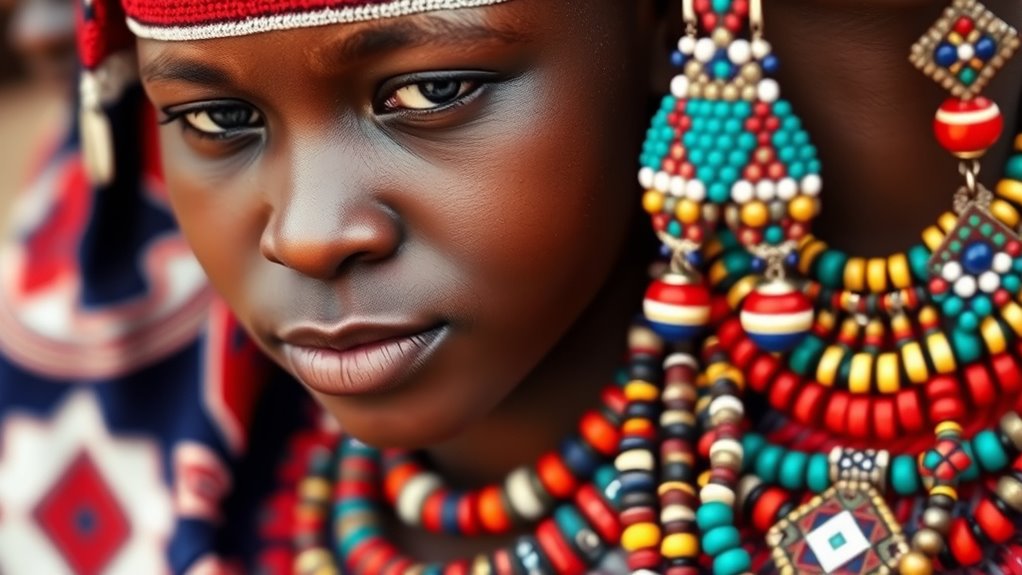
Maasai shúkà and jewelry do more than just adorn—they tell powerful stories about identity, history, and social status. Each pattern and bead arrangement encodes mathematical symbolism, representing concepts like unity, fertility, or age. These designs serve as visual narratives, passing down traditions and values through generations. By wearing specific patterns, you connect to your community’s history, reinforcing bonds and social hierarchies. The craftsmanship also plays a crucial role in textile preservation, ensuring that cultural meanings remain intact over time. The techniques used emphasize continuity and respect for ancestral knowledge. Every bead and fabric choice reflects a deliberate storytelling tradition, making Maasai attire a living archive of cultural identity and collective memory.
The Use of Colors and Symbols in Ndebele Wall Art and Textiles
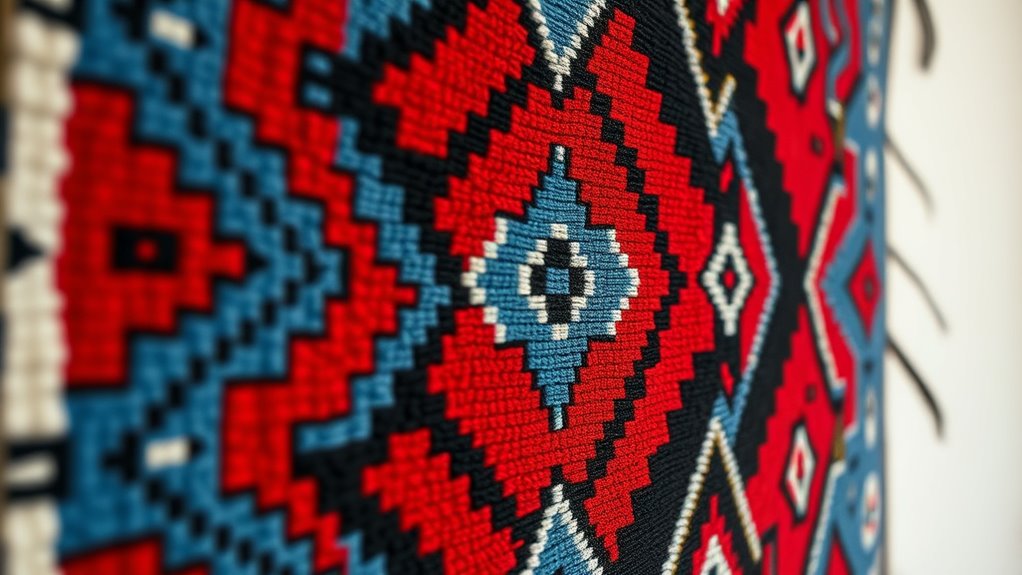
Ndebele wall art and textiles serve as vibrant expressions of cultural identity, where colors and symbols communicate complex meanings. You’ll notice that color symbolism plays a key role, with each hue conveying specific messages: bold reds symbolize love and passion; whites represent purity; and blacks denote spiritual strength. The use of iconography meanings in patterns tells stories or signifies social status. For example:
- Zigzag patterns symbolize life’s challenges and resilience.
- Triangles represent femininity and fertility.
- Dots denote unity within the community.
- Straight lines reflect stability and order.
Additionally, the choice of colors and symbols often aligns with traditional cultural practices, emphasizing their significance in community rituals and storytelling.
The Cultural Identity Expressed Through Kuba Textiles

Kuba textiles vividly express the cultural identity of the Kuba people through intricate patterns, bold colors, and symbolic motifs. You can see this in their indigenous weaving techniques, which have been passed down through generations. Each textile reveals stories, social status, and spiritual beliefs, making textile symbolism central to Kuba culture. The complex geometric designs often symbolize concepts like unity, authority, and ancestry, allowing you to understand their values and history just by observing their cloth. When you examine Kuba textiles, you’re witnessing a visual language that connects individuals to their community and heritage. These textiles aren’t just decorative; they embody identity, tradition, and the collective memory of the Kuba people, making them a powerful form of cultural expression. Electric power generation techniques used in creating some Kuba textiles also showcase their innovative approach to combining practicality with artistry.
Frequently Asked Questions
How Do Textile Patterns Change With Different Generations in African Communities?
You notice that textile patterns evolve across generations, reflecting changing tastes and influences. Through intergenerational storytelling, elders pass down the meanings behind traditional motifs, helping you preserve cultural identity. As younger generations incorporate modern designs, they balance tradition with innovation, ensuring that the rich history remains relevant. This dynamic process keeps textile patterns alive, fostering a sense of continuity and pride within African communities.
What Materials Are Traditionally Used in Making African Textiles?
You use natural materials like cotton, silk, and wool to craft traditional African textiles. Dyed yarns are essential for vibrant colors, often created with natural dyes from plants, minerals, and insects. You apply various weaving techniques, such as intricate patterns and embroidery, to produce textiles rich in cultural significance. These materials and methods showcase African artisans’ craftsmanship and connection to their environment, making each piece uniquely meaningful.
How Do International Markets Influence Traditional Textile Designs?
You see, the global market and cultural exchange greatly influence traditional textile designs. As international markets grow, you might notice designers blending traditional patterns with modern styles to appeal worldwide. This fusion can lead to changes or adaptations in the original designs, reflecting a broader cultural dialogue. While it helps spread African textile artistry, it also challenges preserving authentic traditions amidst evolving global influences.
Are There Specific Textiles Reserved for Particular Social Classes or Occasions?
Yes, you’ll find that certain textiles serve as status symbols and are reserved for specific social classes or occasions. For example, ceremonial attire often features exclusive fabrics that highlight your social standing or mark important events. These textiles communicate your identity and respect for tradition. Wearing these special fabrics during ceremonies underscores their significance, ensuring you stand out and honor cultural customs through your choice of textile.
How Do African Textiles Influence Contemporary Fashion Trends Globally?
You might not realize it, but African textiles influence over 30% of global fashion trends today. They bring rich cultural symbolism into mainstream styles, inspiring designers worldwide. This creates a vibrant global fusion, blending traditional patterns with contemporary fashion. As a result, African textiles help shape a diverse, inclusive wardrobe that celebrates cultural identity and modern innovation, making them a powerful force in today’s fashion industry.
Conclusion
As you explore these textiles, you realize they’re more than just fabrics—they’re stories woven with history, culture, and identity. Sometimes, it’s a coincidence that a pattern or color aligns with your own experiences, reminding you that these traditions connect us all in unexpected ways. In embracing their meanings, you see how textiles serve as a bridge, linking past and present, individual and community, in a beautiful, timeless conversation.

